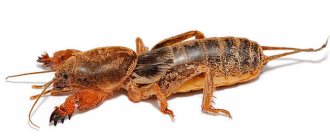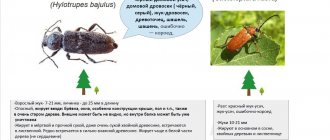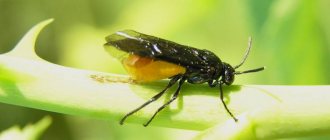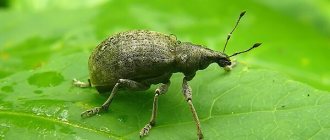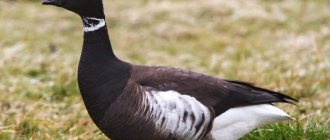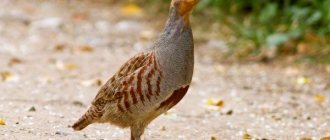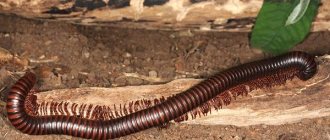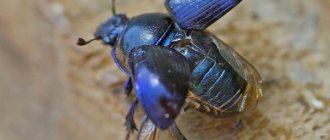- Medvedka: description, structure, characteristics. What does a bear look like?
Medvedka, the name of this insect is well known to all gardeners, summer residents, gardeners, and those who grow plants, and it is familiar in a negative aspect. After all, the mole cricket (aka cabbage mole cricket, aka mole cricket) is a pest for many plants. What are the habits of this insect, what does it look like and how to fight it, read about all this further in our article.
Where did the name “Medvedka” come from?
Mole crickets got their name because of their appearance, large size, brown-brown color and clawed front paws. All this gave reason to compare this insect with the brown
bear
The mole cricket’s second name, “cabbage mole cricket,” comes from its love for young cabbage seedlings. But the third name “mole cricket” comes from the Latin “Gryllotalpa” (properly translated as “mole cricket”) and it is also not accidental. Medvedka is similar to
It is similar to a cricket in its body structure and ability to make sounds, and it is similar to a mole in its ability to burrow into the ground and its extended hands of the front paws, which help dig the ground.
What animals are consumed?
The mole cricket feeds not only on plant foods. As soon as it emerges from the eggs, it consumes the larvae of beetles and click beetles. Having transformed into an adult, the beetle eats some other insects.
Earthworms
Earthworms often become prey for mole crickets. They meet on his way in the process of digging underground passages and are mercilessly eaten, becoming a source of animal protein.
Colorado beetle
The Colorado potato beetle is a well-known pest that destroys potatoes. His meeting with a mole cricket usually has dire consequences. The more powerful cabbage plant destroys the Colorado potato beetle, but it itself causes no less damage to potatoes.
Ladybug
The ladybug is also one of the victims of the mole cricket. True, the beetle does not feed on the ladybugs themselves, since they can fly and are difficult to catch, but on their larvae living in the ground.
Description, structure, characteristics
Mole crickets are arthropod insects and are quite large (for insects) in size. The body length of the mole cricket is from 3.5 to 5 cm. Its body is brownish-brown on top and brownish-yellow below. The body of the mole cricket is covered with thin hairs.
Visual structure of a mole cricket.
The insect's head has a direct or prognathic location in relation to the body. The axis of the body coincides with the axis of the head. The mouthparts are powerful and forward-directed jaws, and next to them are two pairs of tentacles.
The mole cricket's eyes are quite large and clearly visible; they have a facet structure and are located on the sides of the head. On the head itself there are small thread-like antennae.
The pronotum of the mole cricket with the side parts (blades) that hang down is large and flat, it is a distinctive feature of this insect. The head and front part of the body of this creature are covered with a dense chitinous shell, with its help the mole cricket can push and compact the earth when digging holes. Thanks to him, she is somewhat reminiscent of a crayfish.
The abdomen of the mole cricket is thick, it has 1 cm in diameter, and on its top there are anal and genital plates.
The mole cricket has two pairs of wings:
An interesting fact: it is by the venation of the mole cricket's wing elytra that one can distinguish males from females. The larvae of this insect do not have wings.
The mole cricket also has three pairs of limbs, and each of them consists of a coxa, trochanter, femur, tibia and a 3-segmented tarsus. The hind legs are strong, as they are designed for movement and have 1-4 spines on their inner side. The forelimbs, somewhat reminiscent of claws, are essentially a digging apparatus.
Interesting fact: the mole cricket's hearing aid is located on the shins of the forelimbs, just like in grasshoppers, crickets and some other chirping insects.
Cereals
The mole cricket eats grains with pleasure. To combat it, it is recommended to use boiled wheat, mixing it with some insecticide at the rate of 2-3% by weight of the dry product.
The insect also feeds:
- oats;
- barley;
- rye;
The kapestyanka also likes corn. The beetle poses a danger to its seedlings. It is also known that in the absence of cereals, its fertility decreases.
What sounds does a bear make?
The mole cricket, like the cricket, is a “musical” insect, capable of producing chirping trills that can sometimes be heard at a distance of up to half a kilometer. Sounds are made by
friction of rigid front elytra against each other.
The trills of mole crickets serve communication between them, as well as a very important matter - sexual reproduction of insects, since through the performance of “love serenades” males attract females. Females, by the way, are also capable of chirping. The sound power of the mole cricket is 1.4 mW, while for the cricket this figure is only 0.06 mW.
Where does it come from?
Where does the mole cricket come from in the garden? Often it ends up on a plot of land along with manure in which the larvae of this pest live. It can migrate from neighboring areas if yours has higher soil moisture and nutritional properties.
Not only insects can cause irreparable damage to your plantings. On our website you can find useful information about other garden pests. Read all about wild rats, shrews, moles, bats and mice, gophers, wild hamsters. And also about ways to combat wireworms, locusts, whiteflies, sawflies and carrot flies.
Nutrition
All summer residents know that the mole cricket is the most common pest of vegetable, fruit, berry and garden crops. They damage roots, tubers, seeds, underground parts of plants, and sometimes eat young plants. Mole crickets spoil potatoes, corn, beets, cabbage, tomatoes, cucumbers, eggplants, peppers, turnips, pumpkins, watermelons, melons, grapes and many other crops. In the south, exotic citrus fruits (oranges, tangerines, lemons), peanuts, cotton, and tea also suffer from them. In forests, mole crickets damage the roots of many trees: oaks, beech trees, pine trees, etc.
But do not think that mole crickets are exclusively vegetarians (however, very harmful vegetarians), being omnivores, they also eat some living creatures: earthworms,
ladybugs, dragonflies, beetles and some other smaller insects.
Damage caused by mole crickets
If the pest gets into the garden, it can cause serious damage to the future harvest. The pest eats everything that grows in the garden. What adult individuals do is constantly dig tunnels in the ground. At the same time, they eat everything that comes their way. They can destroy seeds, cabbage, peppers, tomatoes, eggplants, and potato plants. The pest gnaws out the inside of the root crops, so they become completely unsuitable for storage.
Mole cricket can reduce the yield of cereals, melons, and legumes. Fruit trees, such as cherry, apple, pear, plum and others, including coniferous trees, also suffer from its vital activity. Up to 15 plants can be affected in one day. This indicates that in a short time the pest is capable of destroying most of the crop. If a mole cricket gets into a greenhouse, then expect trouble, since it has all the conditions for the rapid reproduction of this dangerous, omnivorous insect.
Habitats
These insects live over a wide geographic range, almost everywhere in Eurasia (with the exception of the northern Scandinavian countries), North Africa, the Americas, and Australia. They are not found only in
Antarctica northern arctic regions.
As a habitat, mole crickets most like wet places: meadows, floodplains. They usually live in underground passages and are often found near irrigation canals and in wetlands.
Where does the bear live?
Cabbage grass lives almost throughout the entire European territory, with the exception of the Netherlands, Finland, and Norway. Residents of the Caucasus, Southeast and Central Asia, India, China, the Japanese and Philippine Islands, Australia, South and North America, and the Northern regions of Africa have to fight the pest. In Russia, the insect is found almost everywhere, with the exception of the northern regions.
The beetle lives in damp places, meadows, near ponds, and lives in tunnels underground. The insect likes fertilized, warm, humus soil, so it is often found in summer cottages, wetlands and near irrigation canals.
Lifestyle
These insects prefer to lead a secretive and nocturnal lifestyle, hiding in their burrows during the day and going out to hunt at night. Their presence in a garden plot can be determined by winding, loosened ridges of earth, small holes in the ground, and, of course, by healthy plants that suddenly begin to die for no reason at all.
This is what mole cricket tunnels look like.
It is at night that mole crickets spoil/eat plants; they are also able to fly over considerable distances in search of food (usually they are attracted to bright light). They are also capable of not only flying, but also swimming.
Wintering of insects
Naturally, adult (and not completely) individuals overwinter in soil balls of earth, humus or manure heaps. Going 60-120 centimeters deep, insects survive the cold season well.
With the advent of spring sunlight, warming the soil to 15 degrees, arthropods emerge from hibernation and begin an active lifestyle.
Natural enemies
Of course, the mole cricket has its own enemies in natural conditions, among them rooks, starlings, crows,
hedgehogs, lizards, moles, ants (they pose a threat to mole cricket larvae). Also among pets, the enemy of this insect harmful to the garden is the cat, which can hunt and eat mole crickets like mice and rats, which is of great benefit to the household.
Types, photos and names
Different types of mole crickets practically do not differ from each other, neither in appearance, nor in habits and way of life. They can be distinguished biologically only by the number
chromosomes. Next, we will describe in detail some common types of mole crickets.
Mole cricket
In fact, this is the most common species among these insects. Widely distributed in Europe (with the exception of Scandinavia), lives in a number of Asian countries and northern Africa. Almost everything that we describe here about mole crickets, first of all, concerns the common mole cricket.
African mole cricket
It is slightly smaller in size than the common mole cricket, the body length is 2.5-3.5 cm. It has a brown-yellow body color. Lives in the African tropics and subtropics, but in addition to the “Black
continent" is also found in Southeast Asia and even on the Japanese islands.
Ten-toed mole cricket
This species is distinguished by its small size - from 1.9 to 3 cm. It inhabits both Americas, and it is believed that initially they were found only in North America, but gradually penetrated into South America.
Steppe mole cricket
In appearance it is an exact double of the common mole cricket. This species prefers steppe terrain as a habitat; it lives in the steppe belt of our country, Ukraine, southern Russia, Kazakhstan, Turkmenistan and a number of other Middle Eastern countries.
Characteristics and harm of insects
Compared to other garden parasites, the mole cricket has an impressive size and not the most friendly appearance. The body length can reach 8 cm. When you see a garden monster, a natural desire arises to get rid of it as soon as possible.
Advice:
If the problem is not addressed in a timely manner, the garden plot will turn into a terrifying place.
The only thing that is relatively pleasing is the nocturnal lifestyle of the pest. You won't have to see him often. While a summer resident or farmer sleeps peacefully, the mole cricket squeezes all the juices out of garden and vegetable plants, digs its underground empire with its pincer legs, gnaws the roots with strong jaws and creates tunnels in root crops.
This creature with a bad reputation is also called the top, cabbage, and earthen cancer. It has a long development cycle. A larva emerges from an egg and grows to an adult. Growing up takes 1-2 years. Despite its low mobility, the mole cricket has an excellent appetite and is capable of devastating a large area in the shortest possible time, producing a mass of voracious young individuals.
The peak of activity is the summer, when farmers wait for the harvest. It is not always possible to obtain the desired result due to a crushing blow to fresh plants. Young garden seedlings do not even have time to acquire a full-fledged root system. Predatory beetles quickly bring plant life to a fatal end.
Reproduction
The mating season for mole crickets begins in the spring, after their mass exodus from the burrows in which they spent the winter. Moreover, the mating process itself takes place underground, in burrows. In summer, offspring appear.
Both female and male mole crickets carefully prepare for the birth of future children; they dig complex and branched underground labyrinths and, at a shallow depth (about 5 cm from the surface), create spherical nests 10 cm in diameter. The female mole cricket lays from 300 to 600 eggs in these nesting sites. All this time, the female does not leave her eggs, maintaining the desired temperature and providing ventilation; for this purpose, she continually clears the passages, eats up the roots of plants that cast a shadow on the eggs, etc. All this is critical for the survival of the offspring. The mole cricket eggs themselves are somewhat reminiscent of millet grains; they are oval in shape, yellowish-gray in color and no more than 2 mm in size.
After 10-20 days, the mole cricket eggs begin to hatch into larvae, also known as nymphs, which are small gray six-legged wingless creatures. Otherwise they look similar to adults. For the first 20-30 days, the larvae are under the close protection of the mother, and at the end of this period, the female mole cricket, which gave birth to abundant offspring, unfortunately dies. At this time, the larvae are already crawling into burrows, starting to dig their own holes and look for food. Their development and transformation into a full-fledged adult takes from 1 to 2.5 years.
How to deal with a mole cricket
The fight between this insect pest and the gardener has been going on since ancient times; the arsenal of the fight against mole crickets includes both time-tested folk remedies and modern means of disinfestation. We will look at this in more detail later.
Chemicals
You can make bait for it from steamed grains of corn, oats, barley, wheat or rye, not forgetting to add poison there. Previously, such strong agents as zinc phosphide and dust (DDT) were added to such baits. Now, for this purpose, much safer special poisons are used exclusively for mole crickets, for example, Medvetoks, they do not harm the soil or earthworms, but only kill pests.
Ready-made bait can be purchased at a specialized store. It is optimal to apply it to the soil in early spring, a week before sowing crops.
Agrotechnical measures
Agrotechnical measures, such as deep spring and autumn plowing, regular loosening of the soil, also help get rid of mole crickets in the garden or garden plot.
Destruction by mechanical means
You can try to fight with the mole cricket and various mechanical means.
- Set up traps for them in manure pits. The fact is that they like to spend the winter in manure. And when they gather in the manure pit in winter, it should be scattered around the garden. The mole crickets located there will die from the cold. True, this is only relevant for places with cold climates.
- In a place where mole crickets accumulate, dig a jar or bottle into the ground. Then pour beer in there as bait. Once they get there, the mole crickets will no longer be able to get out.
- Set up light traps for mole crickets - place garden lanterns, and under them containers filled with water and kerosene. Since mole crickets fly towards the light at night, when they hit the lamp, they will fall into the liquid prepared for them.
- You can pour water and sunflower oil into the holes made by pests. Water will push them to the surface, and oil will not allow them to breathe.
Fighting with folk remedies
- – You can try to scare away the mole crickets with unpleasant odors. These come from: rotten fish, onion skins, wormwood, garlic cloves and mint.
- You can also water the soil with diluted bird droppings. Chicken will also work.
- Plant plants that the mole cricket cannot tolerate: garlic, chrysanthemums, perennial cloves.
Precautions in the garden
When using strong chemicals against mole crickets, you must remember to be careful. Instead, other plants, soil or pets should not be harmed.
Prevention of occurrence
A typical insect light trap used to control mole crickets
To protect the area from the appearance of unwanted guests in the form of mole crickets, a number of measures should be taken. Most of them are in the nature of general recommendations carried out when counteracting various pests.
Such measures include:
1 Planting the repellent plants described earlier on the site
2 Digging of areas along the perimeter with furrows with naphthalene or special means Medvetsid
3 Systematic inspection of all types of soil and fertilizers brought to the site (manure, humus, black soil, sand, etc.) to search for mole crickets, their eggs and larvae. Approximately a third of the cases of pest penetration into plots occur with imported soil material
4 Regular weeding and loosening of the soil. Weed removal
5 During the mole cricket’s flight (mid-to-late May), use specialized light traps that are suspended above containers (you can use a regular basin) with a water-kerosene composition. Insects, flying towards the light, stumble upon a trap and fall into a basin, where a layer of kerosene located above the water envelops their bodies, causing suffocation and death
6 Since the mole cricket lives exclusively in acidic soils, it is recommended to carry out annual deacidification of the site by adding dolomite flour or lime to the soil.
At the same time, it must be said right away that some methods of preventing the appearance of pests are not applicable to mole crickets. For example, burying metal mesh around the perimeter of the site, which is very effective against moles, will not have any effect on mole crickets.
Firstly, mole crickets are somewhat smaller than moles, and secondly, unlike moles, they can move both on the ground and in the air.
Interesting Facts
- Gourmets in South-East Asia sometimes consume these insects as a delicacy. Moreover, they are prepared fried, stewed, pickled, with the addition of seasonings or even without them.
- Sometimes the mole cricket brings some benefit, as it destroys the larvae of cockchafers and some other insects that eat plants
- Surprisingly enough, there are benefits from Medvedka in the field of pharmaceuticals as well. So a powder is made from it, which is used as one of the components for a cure for tuberculosis.
What do they eat?
The insect feeds on almost all agricultural crops. His diet also includes food of animal origin.
Tubers
One of the favorite “dishes” of kapustyanka is potato tubers. The insect bites into them, making them unfit for consumption.
Root neck
If cabbage weed damages the root system of plants, for example potatoes, then the leaves quickly wither and the stems fall to the ground. If you notice wilted bushes in an area where there is no lack of moisture, check to see if this beetle has settled there.
Note! The larvae cause no less damage to the root collar of garden plants than adult mole crickets.
They do not have as powerful jaws as their parents. Their diet mainly includes root collars and seeds, which are easy to bite through.
Young shoots and seeds
The beetle loves to feed on young shoots. For this reason, the garden must be protected from mole crickets from early spring until the end of the harvest.
Video
And finally, a short practical video on how to deal with mole crickets.
Author: Pavel Chaika, editor-in-chief of Poznavaika magazine
When writing the article, I tried to make it as interesting, useful and high-quality as possible. I would be grateful for any feedback and constructive criticism in the form of comments on the article. You can also write your wish/question/suggestion to my email [email protected] or Facebook, with respect, the author.
Author page
